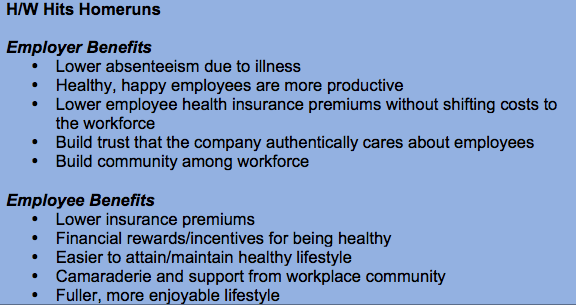- April 1, 2011
- Posted by: Hillary Feder
- Category: Employee Engagement
Culture of Health/Wellness Essential for Culture of Engagement
Companies of all sizes are beginning to see that what’s good for their employees is good for them. Employer-driven health and wellness (H/W) initiatives are here to stay and on the “critical list” as a component of a well-rounded culture of engagement.
Met Life’s annual study of employee benefit trends shows that more companies are jumping on the health-and-wellness (H/W) bandwagon and explains why:
- Companies report active participation by 70% or more of their workforce.
- 48% report health-and-wellness programs are effective at improving productivity.
As a vital component of employee engagement, H/W drives increased productivity. An investment in a H/W program demonstrates true holistic caring for employees, so they can avoid the negative impact of poor health and enjoy their personal and professional life. It conveys a desire to protect their financial well being by staving off over-the-top health care costs.
In addition, there’s a real financial incentive for companies and their workforces to embrace H/W as insurers increasingly move to a sliding scale aligned with the health of the organization. Better-than- average health is recognized and compensated with reduced cost of care and lower insurance premiums—a reason for employers and their workforces to team up to create a culture of H/W. This teamwork results in a more engaged culture as well.
Create a culture vs. one-off program
Like any culture, a healthy culture emanates from the top. That means management not only endorses H/W, but also participates. Walking the walk is how a movement is viewed as a true strategy, becoming an integral part of the culture and gaining mass participation. Movement, healthy eating and other habits that promote a better lifestyle are an ongoing commitment, not a short-term program.
A few thoughts to keep in mind as you prepare to introduce your company’s commitment to H/W:
- Establish a cross-functional, cross-level team to “manage” programming. Tap people who havedemonstrated an interest in H/W. Because they are typically more educated and passionate about one or more key areas, they will enthusiastically welcome their new role as H/W well- being ambassadors/champions.
- Create employee focus groups to determine what information/activities they would find helpful (Annual focus groups are helpful for monitoring soft data-based progress and refreshing programming.)
- Help the team establish initial goals that are meaningful to your workforce as well as your company and determine how to track progress. Hard data could include % of participation, % decrease in illness-based absenteeism and reduced insurance rates, while soft data could focus on improved morale, improved sense of community and fun.
- Create a well-rounded marketing and communications plan for the H/W kick-off and its continued adoption. Touch all five senses.
Recognize diverse needs
Perhaps the most important point to consider from the start is that your workforce spans many levels of H/W knowledge and practice in terms of activity, nutrition, balanced lifestyle, and stress, its causes and negative medical implications. Focus groups can help benchmark levels to help you keep programming fresh, diverse and appealing to the complex workforce.
Fun is always helpful, but not everyone has the same concept of fun. So try new things. Start at basic levels and evolve education to increasingly sophisticated levels. People will jump in when they think they will learn something new, gain a real benefit or have a good time.
Here are plenty of low-cost big ideas to consider:
- Health fairs 1-2 times/year;
- Speakers (authors promoting books, health clubs, etc., often do not charge);
- Healthy options in vending machines/cafeteria;
- “Walk ‘n Talk” meetings;
- Promote farmers’ markets close to your office and employees’ homes;
- Subsidize entry fees for fundraising runs/walks (a community relations bonus);
- Bike racks/locks for those who ride to work;
- Create a “team” to play on a city league or if your organization is large enough create your ownleague;
- Hold team/individual contests/games;
- Partner with a health/fitness center that provides reduced rates to your employees; and
- Provide tangible H/W-related products as promotional tools, incentives, rewards.
We are problem solvers and innovators when it comes to thinking about your team holistically. We’ll help you implement down-to-earth strategies that shape a culture of health and well-being. Call us.
Toll free: 800-742-6800 In Minneapolis/St. Paul: 952-933-8365 www.askhillarys.com



